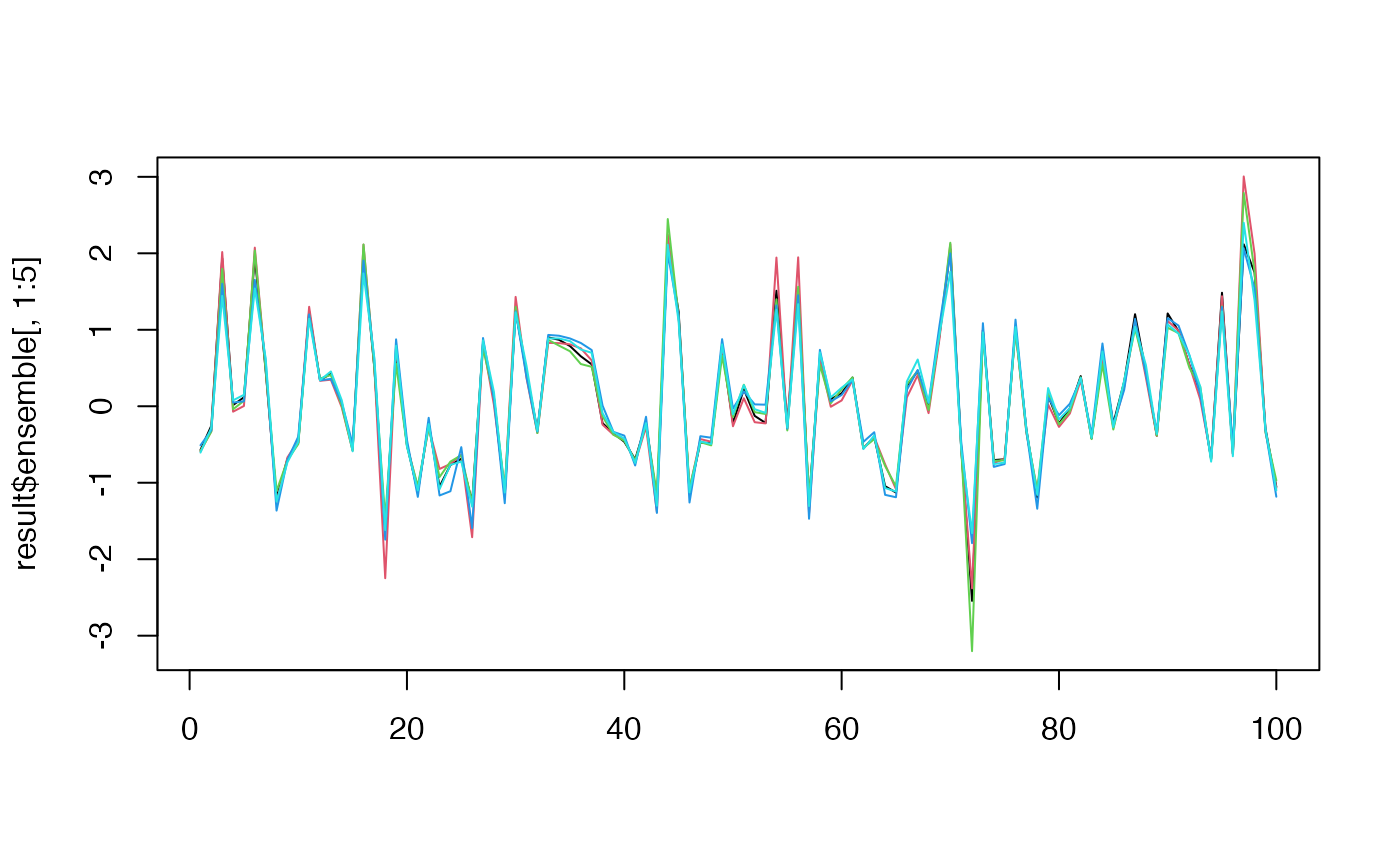Maximum Entropy Bootstrap for Time Series using Rcpp
meboot.RdGenerates bootstrap replicates of a time series using the maximum entropy bootstrap algorithm with Rcpp implementation for improved performance. This method is particularly useful for non-stationary time series and preserves the dependence structure of the original data.
meboot(
x,
reps = 999,
trim = list(trim = 0.1, xmin = NULL, xmax = NULL),
reachbnd = TRUE,
expand.sd = TRUE,
force.clt = TRUE,
scl.adjustment = FALSE,
sym = FALSE,
colsubj,
coldata,
coltimes,
...
)Arguments
- x
A numeric vector or time series object to be bootstrapped.
- reps
Number of bootstrap replicates to generate (default: 999).
- trim
Controls tail behavior. Can be a single numeric value specifying the trim proportion (e.g., 0.10 for 10% trimming), or a list with components:
- trim
Trim proportion for tail calculation (default: 0.10)
- xmin
Lower bound for generated values (optional)
- xmax
Upper bound for generated values (optional)
- reachbnd
Logical indicating whether to allow generated values to reach the boundaries xmin and xmax (default: TRUE).
- expand.sd
Logical indicating whether to expand the standard deviation of the ensemble (default: TRUE).
- force.clt
Logical indicating whether to force the central limit theorem compliance by centering each replicate (default: TRUE).
- scl.adjustment
Logical indicating whether to adjust the scale of the ensemble to match the original data's variance (default: FALSE).
- sym
Logical indicating whether to force symmetry in the maximum entropy density (default: FALSE).
- colsubj
Deprecated parameter from original meboot (included for compatibility).
- coldata
Deprecated parameter from original meboot (included for compatibility).
- coltimes
Deprecated parameter from original meboot (included for compatibility).
- ...
Additional arguments passed to expansion functions.
Value
A list with the following components:
- x
Original time series data
- ensemble
Matrix of bootstrap replicates (n x reps)
- xx
Sorted original data
- z
Intermediate points between sorted values
- dv
Absolute differences between consecutive observations
- dvtrim
Trimmed mean of differences
- xmin
Lower bound used for generation
- xmax
Upper bound used for generation
- desintxb
Interval means satisfying mean-preserving constraint
- ordxx
Ordering index of original data
- kappa
Scale adjustment factor (if scl.adjustment = TRUE)
Details
The maximum entropy bootstrap algorithm generates replicates that:
Preserve the dependence structure of the original time series
Can handle non-stationary time series
Satisfy the ergodic theorem and central limit theorem
Maintain the mean and autocorrelation structure
The Rcpp implementation provides significant performance improvements over the original R implementation, especially for large datasets and many replications.
References
Vinod, H. D., & Lopez-de-Lacalle, J. (2009). Maximum entropy bootstrap for time series: The meboot R package. Journal of Statistical Software, 29(5), 1-19.
Examples
# \donttest{
# Basic usage with a time series
set.seed(123)
x <- ts(rnorm(100), start = c(2000, 1), frequency = 12)
result <- meboot(x, reps = 1000)
# Plot first few replicates
matplot(result$ensemble[, 1:5], type = "l", lty = 1)
lines(result$x, col = "black", lwd = 2)
 # With custom bounds
result_bounded <- meboot(x, reps = 100,
trim = list(trim = 0.1, xmin = -3, xmax = 3))
#> Warning: expand.sd and force.clt were set to FALSE to enforce limits xmin/xmax.
# With scale adjustment
result_scaled <- meboot(x, reps = 100, scl.adjustment = TRUE)
# }
# With custom bounds
result_bounded <- meboot(x, reps = 100,
trim = list(trim = 0.1, xmin = -3, xmax = 3))
#> Warning: expand.sd and force.clt were set to FALSE to enforce limits xmin/xmax.
# With scale adjustment
result_scaled <- meboot(x, reps = 100, scl.adjustment = TRUE)
# }